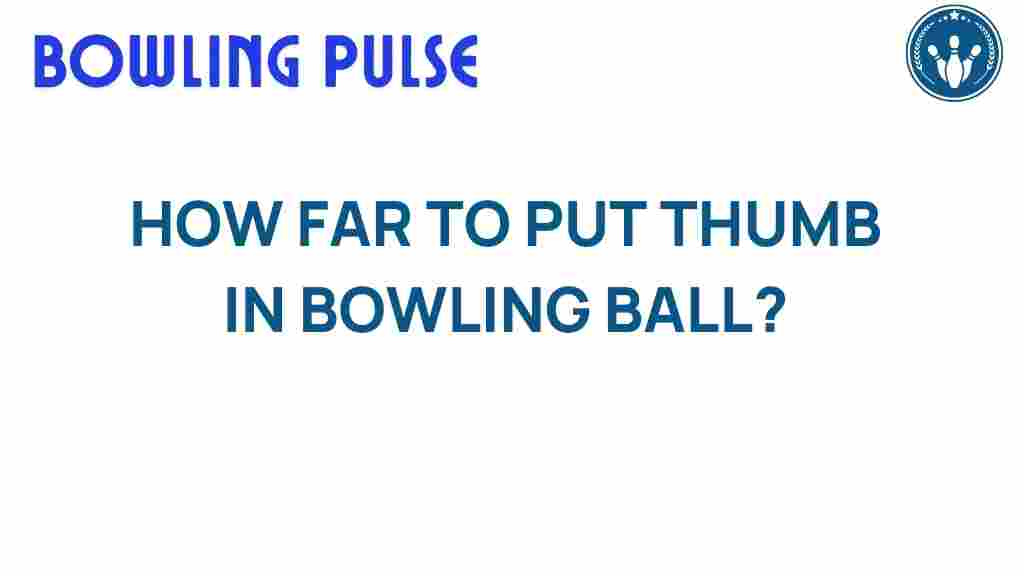Unlocking the Perfect Grip: How Far Should Your Thumb Go in the Bowling Ball?
When it comes to mastering your bowling technique, one of the critical components that often gets overlooked is thumb placement. The way you position your thumb inside the bowling ball can significantly influence your bowling performance. Whether you are an amateur bowler looking to improve your game or a seasoned player refining your skills, understanding the nuances of the bowling grip is essential.
In this article, we will explore the optimal thumb placement for achieving a perfect grip, provide valuable bowling tips, and delve deep into the bowling fundamentals that can elevate your game. Let’s unlock the secrets of a perfect grip!
The Importance of Thumb Placement in Bowling
The thumb is one of the three contact points you have with the bowling ball, and its position can affect your release, spin, and overall control. Getting your thumb placement right is crucial for:
- Improved accuracy
- Better consistency
- Enhanced power and spin
- Reduced risk of injury
Understanding how far your thumb should go into the bowling ball is fundamental in achieving a reliable bowling grip that complements your unique playing style.
Step-by-Step Process for Perfecting Your Thumb Placement
Follow these steps to identify and achieve the ideal thumb placement for your bowling grip:
1. Choose the Right Ball
The first step is to select a bowling ball that fits your hand. A properly fitted ball will make it easier to position your thumb correctly. Consider the following:
- Weight: Choose a ball that is 10% of your body weight.
- Finger holes: Ensure the finger holes are not too tight or too loose.
2. Insert Your Thumb
Once you have the right ball, slide your thumb into the thumb hole. Here’s how far your thumb should go:
- Your thumb should go in until the first knuckle is at the edge of the hole.
- A good test is to ensure that your thumb can be easily removed without too much resistance.
3. Position Your Fingers
After placing your thumb, insert your fingers into the other holes. Typically, you should use your middle and ring fingers. Here’s how to position them:
- Your fingers should go in up to the second knuckle.
- Ensure that your grip feels comfortable and natural.
4. Test Your Grip
Once you have your thumb and fingers positioned:
- Hold the ball at waist level and feel how it balances.
- Practice lifting the ball while maintaining your grip.
Adjust your thumb placement if you feel too much strain or if the ball feels unstable.
5. Practice Your Release
The release is where your thumb placement significantly impacts your bowling performance. Focus on these tips:
- Release the ball smoothly, allowing your thumb to exit first.
- Follow through with your fingers to ensure a perfect spin.
Troubleshooting Common Thumb Placement Issues
Even with the right techniques, you may encounter issues with your thumb placement. Here are some common problems and solutions:
1. Thumb Gets Stuck
If your thumb gets stuck in the ball:
- Check that the thumb hole is not too tight.
- Consider using a ball with a larger thumb hole or a custom thumb insert.
2. Inconsistent Release
For bowlers experiencing an inconsistent release:
- Re-evaluate your grip pressure; it should be firm but relaxed.
- Practice your release mechanics to build muscle memory.
3. Pain or Discomfort
If you feel pain or discomfort in your thumb:
- Adjust the depth of your thumb in the hole.
- Consider consulting a professional for a fitting.
Bowling Tips for Enhanced Performance
Improving your bowling technique goes beyond just thumb placement. Here are some additional bowling tips to enhance your overall game:
- Practice regularly: Consistent training helps solidify the bowling fundamentals.
- Watch your stance: A stable stance is vital for balance and accuracy.
- Focus on your follow-through: It ensures that your shot maintains the intended line.
Understanding Sports Mechanics in Bowling
Bowling is not just a game of luck; it is a sport that requires a deep understanding of sports mechanics. Here are some insights:
- The biomechanics of your approach and delivery can affect your performance.
- Proper body alignment and weight transfer play crucial roles in achieving a successful delivery.
Investing time in understanding these mechanics can significantly improve your bowling performance.
Bowling Training for Amateurs
If you’re an amateur bowler looking to enhance your skills, consider the following training approaches:
- Join a league: Competing in a league provides structured practice and feedback.
- Take lessons: Professional coaches can offer personalized advice on your technique.
- Video analysis: Recording your throws can help identify areas for improvement.
For more detailed training tips, check out this comprehensive guide on bowling training.
Resources for Further Learning
To deepen your understanding of bowling technique, consider exploring various resources:
- Bowling Digest – A great source for articles on technique and training.
- YouTube Bowling Channels – Visual learning can help identify key areas for improvement.
Conclusion
Mastering your bowling grip through proper thumb placement is essential for achieving consistent results on the lanes. By following the steps outlined in this article, troubleshooting common issues, and incorporating effective bowling tips, you can unlock your full potential as a bowler. Remember, practice is key, and understanding the bowling fundamentals will lay the foundation for your long-term success. Keep training, stay dedicated, and watch your bowling performance soar!
This article is in the category Techniques and created by BowlingPulse Team
